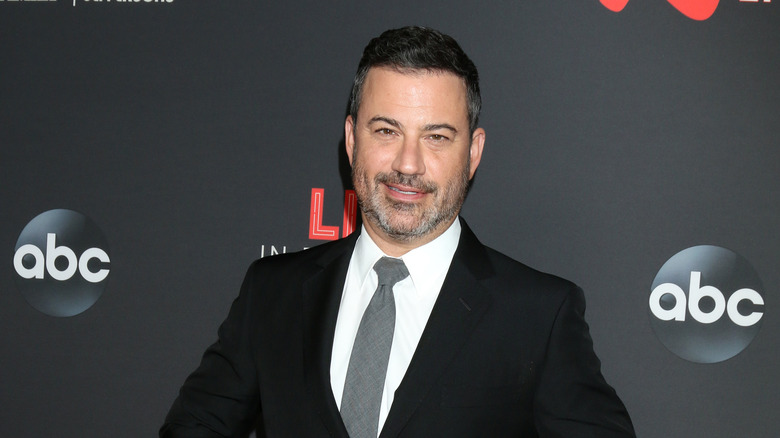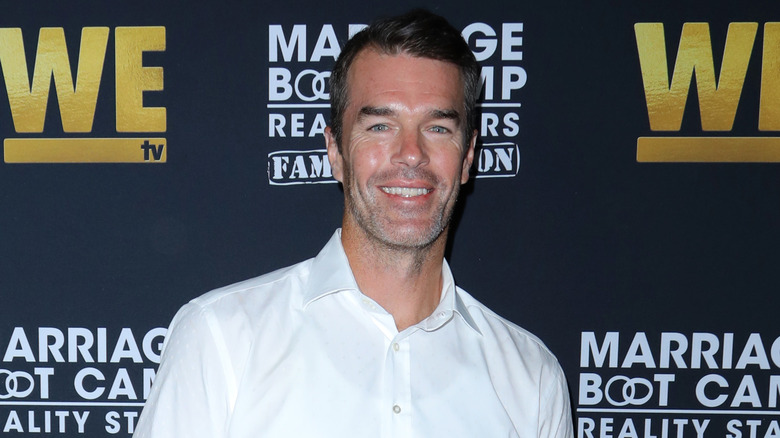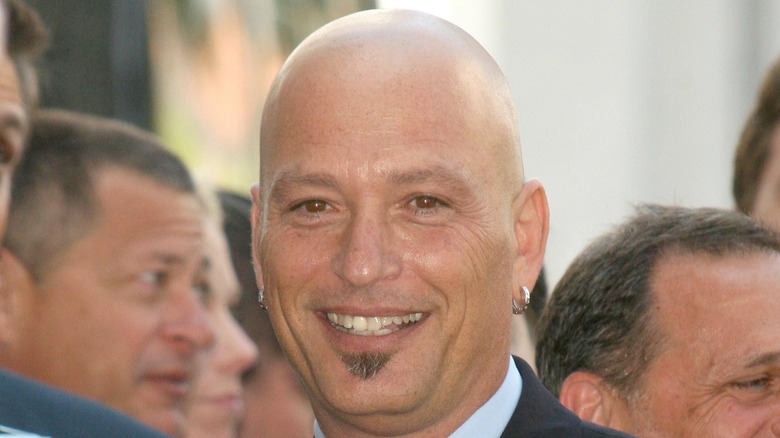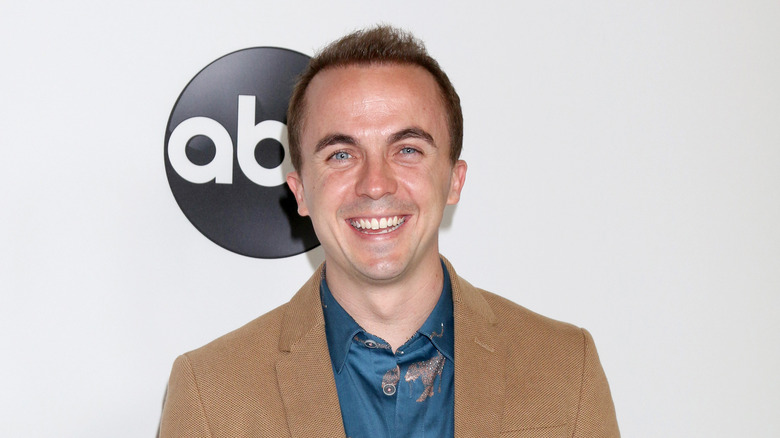Celebrities Who Were Diagnosed With Rare Diseases
It used to be commonplace for celebrities to go to great lengths to keep diseases and other health issues to themselves, according to Slate. However, that gradually started to change. In 1998, for instance, Michael J. Fox revealed he had Parkinson's disease (via The Washington Post). Fast forward to 2013, and Angelina Jolie revealed she had tested positive for one of the genetic mutations associated with a higher risk of breast cancer in 2013. She made the decision to undergo a prophylactic double mastectomy, and she detailed the experience publicly in an op-ed for The New York Times.
Nowadays, it's commonplace for celebrities to go public with both physical and mental health conditions (via MedPage Today). This may help others not feel so alone. For people diagnosed with rare diseases, however, that comfort can be harder to find. "People affected by rare diseases often have limited coping resources and sometimes face stigma," according to a 2017 study published in the Journal of Applied Communication Research. For that reason, it can be very meaningful when celebrities such as these go public about having been diagnosed with a rare disease.
Jimmy Kimmel lives with this chronic neurological disorder
Comedian and late-night television talk show host Jimmy Kimmel lives with narcolepsy, a rare neurological disorder that affects the "brain's ability to control sleep-wake cycles," according to the National Institute of Neurological Disorders and Stroke. The institute further explained that "people with narcolepsy may unwillingly fall asleep even if they are in the middle of an activity like driving, eating or talking." As a result, narcolepsy can interfere with one's daily activities, particularly before it's diagnosed or if it isn't being treated.
Most people with narcolepsy begin experiencing symptoms by the time they are young adults, which was the case for Kimmel, who had it for some time before being diagnosed. "I did know that every afternoon between about three and six, I would get very tired for no reason. I would doze off in meetings, watching TV, even driving," he told Esquire in a 2003 interview. "You know how when you're regular tired, your whole body is tired? With narcolepsy, just the inside of your head is tired. It's like somebody's gently sitting on your brain."
For a long time, though, Kimmel believed he was just not getting enough sleep. When he finally told a doctor that he was drinking "gallons of iced tea" just to get through the day, the doctor figured out this was more than mere tiredness and prescribed Provigil, a drug frequently used in cases of narcolepsy as well as sleep apnea.
Sarah Hyland was born with a rare and chronic kidney disease
Sarah Hyland may be most famous for having played Haley Dunphy on ABC's "Modern Family," but for people with kidney disease, Hyland is also a hero and an inspiration. Hyland was born with kidney dysplasia, the actress told Self. She revealed her history with the condition and the many treatments she has undergone.
In kidney dysplasia, "internal structures of one or both of a fetus' kidneys do not develop normally in the womb," according to National Institute of Diabetes and Digestive and Kidney Diseases (NIDDKD). After filtering blood to produce urine, as the kidneys are meant to do, the urine has no place to go. Instead of emptying into the bladder, from which it would normally be released, urine collects in the kidneys, forming cysts that interfere further with kidney function.
According to the NIDDKD, many babies born with this condition (which is often congenital but can also be caused by the mother's having taken certain medications during pregnancy) don't survive birth. Those who do may need regular dialysis treatments or a kidney transplant. Hyland has needed both. Before the age of 30, Hyland underwent two kidney transplants — one from her father when she was 21, which was later rejected — and another when she was 26. She also needed multiple dialysis treatments per week, according to Kidney.org.
Nick Jonas inspires many by sharing his diagnosis with type 1 diabetes
Nick Jonas was 13 years old when he was diagnosed with type 1 diabetes (via Medline Plus). Type 1 diabetes isn't caused by diet and lifestyle factors and is often referred to as "juvenile diabetes" because it is frequently diagnosed by young adulthood. It's also sometimes referred to as insulin-dependent diabetes because the condition means that the pancreas doesn't make sufficient insulin to metabolize blood sugar into energy for the body's use, according to the Centers for Disease Control and Prevention. To prevent blood sugar from building up in the bloodstream, people with type 1 diabetes require insulin injections.
"I use an insulin pump to help manage my diabetes, check my blood sugar frequently, and do my best to get to know my body and get to feel out if I am high or low. More than anything, it's trusting my doctor and following all of her advice," Jonas told MedlinePlus. He also tries to eat healthy and engage in physical exercise. "I think it's just about being honest and vocal with the people who you are working with, or trainers and friends who you might be training with, about the disease and how to take care of situations should they arise," he said. Jonas is also an advocate for others with type 1 diabetes, raising money for diabetes research and offering moral support to children who have been diagnosed (via Radio Disney).
Kristin Chenowith has Ménière's disease
For years, Kristin Chenoweth has been attempting to manage migraines that are complicated by a rare inner ear condition called Ménière's disease, she told Brain and Life. "Ménière's is a disorder of the inner ear that causes severe dizziness, ear-ringing, and a feeling of fullness or congestion in the ear," according to the National Institute on Deafness and Other Communication Disorders, which noted that some people with Ménière's disease have such extreme vertigo, they have trouble standing upright without falling.
Chenoweth first realized something was wrong when she was 25 years old. She was performing with the Virginia Symphony and overcome by bright flashes of light, "viselike" head pain, dizziness, nausea and peripheral vision loss, Brain and Life detailed. These symptoms, along with light sensitivity, remained with Chenoweth for days. This episode was followed by others at the rate of about once every two months, which is a lot for anyone to deal with, but especially for someone whose career depends on being able to perform publicly under bright stage lights.
Eventually, Chenowith was diagnosed with chronic "vestibular migraine" (which refers to a migraine complicated by vertigo and dizziness) and Ménière's, which exacerbates vestibular migraines and can result in hearing loss. Although there were times when Chenoweth thought her condition would be the end of her career, she has persevered thanks to medication and her attempts to limit triggers.
Stranger Things' Gaten Matarazzo was born with cleidocranial dysplasia
"Stranger Things" star Gaten Matarazzo, was born with "a rare genetic disorder that affects the growth of teeth and bones" called cleidocranial dysplasia (CCD), according to NBC News and Matarazzo, himself, who is open about the condition on Instagram.
CCD is caused by an issue with the RUNX2 gene, which is critical to bone and cartilage formation, according to Johns Hopkins Medicine. In most cases, CCD is familial, but in Matarazzo's case, it was a spontaneous mutation, he told People in 2016, which is when his then-newfound fame began providing him with a platform for speaking openly about his condition.
"There's a one in a million chance that you have of getting it," he continued. "I have a very mild case so it doesn't affect me as much." Nevertheless, Matarazzo has had several surgeries to extract extra teeth and expose his adult teeth. This includes a surgery he underwent in early 2020, in which he had 14 "supernumerary teeth" extracted (via Instagram). Afterwards, Matarazzo remarked that this particular surgery may be the last one he needs for this condition.
Ryan Sutter and his Lyme disease diagnosis
Firefighter and television personality Ryan Sutter, who won the first season of ABC's hit dating show, "The Bachelorette," has been coping with a cluster of health issues since February 2020. This was when he first presented with extreme fatigue as well as "deep body and muscle aches, fevers, night sweats, full body itching with no rash, headaches, neck and throat swelling, congestion, light headedness, nausea, and just general all around not feeling good," he wrote in a late 2020 Instagram post.
At the time, he revealed he was "functional" and was continuing to work as a firefighter, but his symptoms had not abated. If anything, they had worsened in the absence of a definitive diagnosis. "I am not taking any medications, maintain a healthy diet and am doing my best to get rest," he said. "Most days I feel about 70%. Somedays I feel a bit better and somedays I can barely get out of bed."
Sutter told People that he began to see improvements in his health in 2021. On February 23, he even posted an Instagram photo of himself doing bench presses — and on April 9, he posted a photo of himself in a hyperbaric chamber, which is a medical treatment designed to accelerate the body's healing by delivering pressurized oxygen (via Michigan Health). In late May, 2021, however, he disclosed on his wife's podcast that he was diagnosed with Lyme disease, which is exacerbated by mold. "So my immune system was weakened," he said, "making it difficult to fight off infections." Sutter also reported that he was starting to feel better with treatments and changes to his diet.
Canadian fashion model Winnie Harlow's vitiligo diagnosis brought this condition out of the shadows
Vitiligo, is a rare skin disorder that causes the skin to lose pigment, according to Cleveland Clinic. It progresses slowly and can stop with just a few patches of depigmented skin. More often than not, though, it goes much further and can be extremely distressing to those who have it, according to The New York Times.
For a long time, the only celebrity most knew to have had vitiligo was pop star Michael Jackson, whose autopsy confirmed that he had it (via Autopsy Files). For the most part, Jackson kept his diagnosis to himself. When he did speak of it publicly, it was mainly in response to accusations that he had been bleaching his skin. Today, however, people with vitiligo have an outspoken role model in whom they can find inspiration: Canadian fashion model Winnie Harlow.
Harlow has appeared on two Vogue covers in the past two years alone, her skin condition completely undisguised. "I happen to have vitiligo and I'm proud of it," she told Fashion Week Daily in late 2020, "but I'm also not a spokesperson for it just because you want me to be, or just because I have a skin condition. That's not how life works. That makes it difficult. It's not about me being private about my skin condition. I love talking about it. But it's not the only thing about me."
MTV's Karen Duff Duffy was diagnosed with sarcoidosis
In 1997, model, actress, and MTV VJ Karen "Duff" Duffy went public with her diagnosis of the rare inflammatory condition, sarcoidosis, which she had been dealing with since 1995 (via The Baltimore Sun). In sarcoidosis, the immune system goes into "overdrive," according to the Foundation for Sarcoidosis Research (FSR), causing "tiny clumps of inflammatory cells" in organs throughout the body (in the lungs of 90% of patients). These clumps can damage the affected organs, and that damage can be permanent if left unchecked. There is currently no known cure, but patients such as Duffy can be treated with medications.
No one has been more effective at raising sarcoidosis awareness than Duffy, whose diagnosis took 11 months after she first began experiencing debilitating headache and loss of feeling in her extremities (via The Baltimore Sun). In 2017, Duffy published her second book on sarcoidosis according to FSR, of which Duffy is a member of the Board of Directors. "The effects of sarcoidosis are different but the emotions and physical pain from managing it are universal," Duffy wrote for FSR. Making things more difficult, most people with sarcoidosis appear to perfectly fine to everyone else. "Living with an invisible illness feels like picking up a heavy dresser the minute you wake up and you don't put it down until you go to bed at night," Duffy wrote.
Howie Mandel has given a humorous and sympathetic face to OCD
Although you've likely heard of Obsessive-Compulsive Disorder) OCD, it is relatively rare. That said, many do have "'subclinical' or 'subthreshold' OCD symptoms," Michael G. Wheaton, assistant professor of psychology Michael G. Wheaton, explained in an article for Barnard College.
OCD has been defined as a "long-lasting disorder in which a person has uncontrollable, reoccurring thoughts (obsessions) and/or behaviors (compulsions) that he or she feels the urge to repeat over and over," according to the National Institute of Mental Health. In the rare cases in which it presents in severe form, the way it did and does with comedian Howie Mandel, it can be debilitating, according to Healthline.
Mandel's severe OCD is complicated by Attention Deficit Hyperactivity Disorder (ADHD), which can lead to impulsive behavior in addition to lack of focus and difficulty sitting still. Mandel told ADDitude Magazine that he had no intention of going public with his lifelong experience with OCD, but he "impulsively revealed" it on a talk show, after which he was "devastated." Since then, he's come to recognize that his revelation helped people who were experiencing the same things. "Whatever you're dealing with in life, know that you're not alone," he wrote for the magazine.
Model Gigi Hadid's Hashimoto's diagnosis has not stopped her from modeling
If you have Hashimoto's disease, your immune system perceives your thyroid as a threat and attacks it, damaging the gland so that it cannot make enough thyroid hormone to support normal metabolism. This is known as hypothyroidism, according to the National Institute of Diabetes and Digestive and Kidney Diseases. Hashimoto's may be most known for causing unwanted weight gain, but it can also contribute to high cholesterol, which can lead to heart disease, and in rare, untreated cases, it may lead to "myxedema coma," in which the "body's functions slow to the point that it becomes life-threatening."
Gigi Hadid, who has been modeling since 2014, went public with her diagnosis of Hashimoto's in 2016, according to Business Insider. However, it wasn't until 2018 that she took on the body-shamers who have criticized her weight and its fluctuations during her career. "For those of you so determined to come up [with] why my body has changed over the years, you may not know that when I started [modeling at] 17 I was not yet diagnosed [with] Hashimoto's disease; those of u who called me 'too big for the industry' were seeing inflammation & water retention due to that," she tweeted, receiving an outpouring of support in return and bringing greater awareness to Hashimoto's disease.
Frankie Muniz has a history of transient ischemic attacks
In 2017, during an episode of "Dancing with the Stars," former star of television's "Malcolm in the Middle" and once professional race car driver Frankie Muniz revealed that he experiences memory loss and that he actually is unable to remember starring on the popular show (via Entertainment Weekly). The cause of his cognitive issues may be that he had multiple concussions over the course of his life, starting at the age of seven when he was hit while playing goalie in a soccer game.
Muniz also was involved in a serious race car crash during his years of racing, according to People. But he made a far more significant revelation during an interview with Entertainment Weekly after that "Dancing with the Stars" episode. Since 2012, he's had as many as 15 transient ischemic attack (TIAs). TIAs, which is also known as mini strokes, resembles a stroke in many ways except that it lasts only temporarily. A TIA is caused by a temporary blockage of blood flow to the brain, according to the American Stroke Association.
All of that being said, Muniz can't be entirely sure of the cause of his condition. Although Muniz has retired from acting and race car driving, he is alive and well. He and his wife Paige welcomed their first child, baby boy Mauz Muniz, in March 2021 (via People).
Venus Williams has an autoimmune disease
Sjögren's disease is an autoimmune condition that affects the entire body, causing symptoms including extensive mucous membrane dryness and leading to complications such as "profound fatigue, chronic pain, major organ involvement, neuropathies and lymphomas," according to the Sjögren's Foundation.
Venus Williams has been attempting to manage the condition since 2004, according to Prevention. Initially, Williams experienced extreme fatigue and shortness of breath. "No matter how hard I worked, I ... never felt in shape. It was really frustrating," she told the site. Her symptoms progressed and within a few years, she was also experiencing joint pain, numbness, hand swelling, dry eyes, and dry mouth. By 2011, Williams was unable to play in the U.S. Open due to her symptoms.
It took seven years from the onset of Williams' symptoms, however, for her to finally get her diagnosis. "Unfortunately, that's typical of people with autoimmune disease," she told Prevention. "They're misdiagnosed or too sick to function. I literally had professional tennis taken away from me before I got the right diagnosis." Thanks to her diagnosis and appropriate treatment, though, Williams is back in the game, and she's considered a significant role model for those dealing with Sjögren's, according to Sjögren's Life.
Marianna Palka is living with a rare and fatal brain disorder
Huntington's disease is a rare and fatal genetic neurological disorder that causes "deterioration in a person's physical, mental, and emotional abilities, usually during their prime working years, and currently has no cure," according to the Huntington's Disease Society of America. Huntington's disease is referred to as a "family disease" because if a parent has it, their kids have a 50/50 chance of developing it too.
Filmmaker and "Glow" actress Marianna Palka knew for a long time that she could have the disease as her father has it, according to CGTN America. In 2013, she sought genetic counseling and, eventually, testing for the genetic marker. Palka tested positive, which means that eventually she will have to confront Huntington's disease head on, just like she had been watching her father do for years.
Instead of hiding her diagnosis, Palka bravely became the subject of Lucy Walker's documentary short, "The Lion's Mouth Opens "(the title comes from a Bob Dylan poem about the late entertainer Woody Guthrie who died of Huntington's). The short showed Palka taking the test, sharing her fears with her friends, and eventually getting the results. According to her interview with CGTN America, Palka chose to go public so as to raise awareness and research funding. The film ended up raising more than $100,000, and Palka continues to live and work in Hollywood as of this writing.














